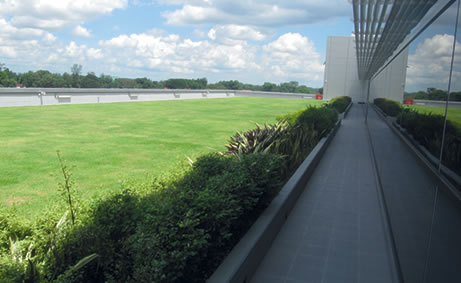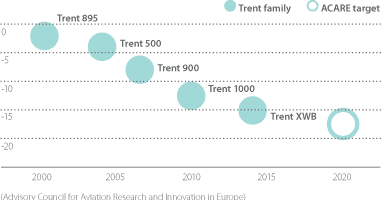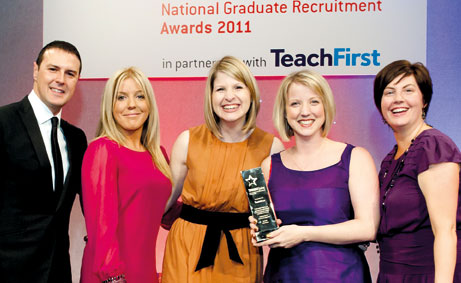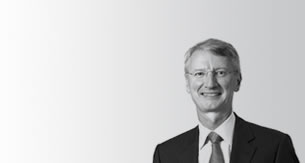
The ‘green roof’ of our manufacturing facility in Singapore gained a BCA award for environmental construction.
Environment
Our environment strategy focuses on three key areas:
- 1. maintain our drive to reduce the environmental impact of all our business activities;
- 2. further reduce the environmental impact of our products; and
- 3. develop entirely new low emission and renewable energy products.
1. Maintain our drive to reduce the environmental impact of all our business activities
Greenhouse gas emissions
We recognise the need to reduce the global greenhouse gas emissions (GHG) within our operations. For the past two years individual reduction targets and budgets have been agreed for our top 25 energy consuming sites. This has resulted in a further five per cent reduction (normalised on turnover) during 2011 in total GHG emissions (1) (including product test and development). Emissions from our facilities (excluding product test and development) have reduced by six per cent since 2009 compared with our five per cent reduction target by 2012 (2). In absolute terms, total GHG emissions have increased to 586.5 kt CO2e (scope 1 and 2).
(1) Following further validation in 2012, the Group GHG emissions for 2009 have been re-stated. (2) Energy/GHG data for 2011 has been forecast based on data collected during January to October 2011. For details of the methodology see our ‘Basis of Reporting’ available at www.rolls-royce.com.
In 2011, we invested over £3.5 million in energy improvement projects including the upgrade of lighting, boiler controls and metering.
Our new facility at Seletar received the Singapore Government’s Building Construction Authority (BCA) Green Mark (Platinum) award in construction, for having a reduced environmental footprint.
Progress on certification
Rolls-Royce continues to maintain accredited third-party certification to ISO 14001 for its environmental management systems, achieving full global re-certification in 2011.
Global supply chain
In 2011, we led Global and Regional Supplier Forums, which focused on near-term and long-term improvements. We also hosted regional supplier groups, culminating in a global best practice sharing event aimed at promoting the application of lean techniques across the supply chain.
2. Further reduce the environmental impact of our products
We believe that we can make a significant contribution to mitigating emissions by providing increasingly efficient products worldwide. We benefit from independent expert advice from an Environmental Advisory Board made up of distinguished academics who are leading authorities in their respective fields to inform business strategy and design process. In 2011, the Group renewed its commitment, now extended to 2050, in taking a leading role in the goals set by the Advisory Council for Aviation Research and Innovation in Europe (ACARE). These challenging goals include:
- reducing aircraft CO2 emissions by 75 per cent per passenger kilometre
- reducing noise by 65 per cent; and
- 90 per cent reduction in oxides of nitrogen (NOx) relative to the year 2000.
The environmental improvements already achieved by the Trent 900 and 1000 engines for the Airbus A380 and Boeing 787 respectively, and in future the Trent XWB for the Airbus A350 XWB, will help us make progress meeting our contribution towards the ACARE goals.
Chart shows target of 20% lower CO2

In the marine segment, the Rolls-Royce Environship concept, received the prestigious ‘Next Generation Ship’ award at the Nor-Shipping event held in Norway. The Rolls-Royce Bergen B-Series lean-burn gas engines, as used in the Environship, emit around 20 per cent less CO2 than comparative diesel engines. The use of gas fuelled engines means that NOx emissions are reduced by about 90 per cent and SOx emissions are negligible. These emissions already meet the International Maritime Organization legislation due to come into force in 2016.
3. Develop entirely new low emission and renewable energy products
The Group is investing in other renewable energy sources such as tidal power, working in partnership with the UK Energy Technologies Institute. In addition, we are working with customers and fuel companies to ensure that future biofuels, which will be part of the solution for aviation towards 2050, meet our requirements, with the important caveats that they are sustainable, do not compete with the growth of food crops and are used in the most effective way to maximise the reduction in GHG emissions.

Nuclear generation delivers low-carbon power. Rolls-Royce has extensive knowledge of nuclear safety and I&C technology.
Nuclear power will represent an important component of future low-carbon electricity generation. We have substantial experience in this area gained through supplying power systems for the Royal Navy nuclear submarine fleet for many decades. Our core capabilities in safety and I&C will enable the Group to provide solutions in this area that will help address the requirements for low or zero carbon power generation.
Our people
Our working environment
We seek to create an inclusive working environment that attracts and retains the best people, enhances their flexibility, capability and motivation, and encourages them to be involved in the ongoing success of the Group.
The organisation is experiencing a period of significant change as we grow and invest globally. We continue to place great value on giving a voice to our workforce and engage with our employees in many ways throughout the world to ensure they are kept informed of changes that may impact them. For example, employee opinions are obtained via a two-year rolling engagement programme and improvement activities are then embedded into local and corporate business planning activities. In addition we have established communication channels which provide updates on key business changes and activities.
Rolls-Royce employs 40,400 people in more than 50 countries. Our workforce is dispersed globally across our business segments as follows:
Business segments average number of employees 2011
| Employees | |
|---|---|
| Civil aerospace | 20,600 |
| Defence aerospace | 6,800 |
| Marine | 9,400 |
| Energy | 3,600 |
| Total | 40,400 |
Ethics
The Global Code of Business Ethics (Global Code) supports the Group’s approach to business conduct and defines its ethical principles and behaviours. Internal and external assessments of the Global Code during 2011 confirmed that it represents best-in-class standards.
During the year, the Group completed a review of its anti-bribery and corruption related policies and procedures. This review considered applicable law, including the UK Bribery Act, which came into force on July, 1, 2011. We also put in place a compliance organisation, led by a Chief Compliance Officer. We issued a number of new and updated global policies in multiple languages including: raising concerns, conflicts of interest, competitive intelligence and sponsorships and charitable donations. Training was developed to support these as required.
Rolls-Royce actively supports aerospace and defence industry initiatives to drive responsible business behaviour in the sector. We are represented on the Business Ethics Committee of the Aerospace and Defence Industries Association of Europe (ASD) and we are one of the international companies on the task force managing the International Forum for Business Ethics (IFBEC), a body which brings together US and European aerospace and defence companies to share best practice and develop common standards.
Encouraging diversity
Our global governance framework for diversity includes a senior executive Global Diversity Steering Group that provides leadership and shapes strategic direction.
During 2011, our most senior executives have been reverse mentored by a colleague who is junior to them in the organisation. The reverse mentors are a diverse group in terms of gender, nationality, business, function and their working location. The aim is to give senior executives a different perspective from a colleague who can share diverse experiences and ideas.
Lord Davies of Abersoch, on behalf of the UK Government, outlined a number of recommendations in 2011 to improve gender diversity in UK boardrooms. We will take opportunities to increase diversity at Board level, and have committed to make demonstrable progress on this by 2015.
Overall female representation across our global workforce is 15 per cent, seven per cent at the senior executive level and six per cent in our Group Leadership Team (GLT). Approximately two thirds of our workforce is in engineering or manufacturing roles where female representation has been historically low. We continue to counter this through active involvement in education outreach along with recruitment and development planning in order to maximise the potential of diverse talent across our global business. We are encouraged by some of the progress we are making in graduate recruitment where female representation has steadily increased over recent years. 25 per cent of participants in our graduate development programmes are female and this increases significantly in functions outside of engineering and manufacturing.
We participate in the FTSE 100 Cross Company Mentoring Programme, the objective of which is for the chairmen and chief executives to provide advice and guidance to senior females with the aim of attaining a non-executive and/or an executive director role. Our Chairman is a mentor and three of our female executives have participated to date.
The Group is committed to developing a diverse workforce and equal opportunities for all. Our policy is to provide, wherever possible, employment training and development opportunities for disabled people. We are committed to supporting employees who become disabled during employment and helping disabled employees make the best use of their skills and potential.
Learning
During 2011, we provided over 3,500 learning solutions to our employees from all of our 57 countries, resulting in 35,500 employees undertaking more than 105,000 days of learning. We also built new Learning and Development Centres in Singapore and Ålesund, Norway. The centres will deliver training to both customers and employees in the regions.
Learning investment for 2011 was £38 million.
Recruitment
In 2011, over 2,500 experienced professionals were recruited to support the growth of our business, more than double the previous year. More than 50 per cent were recruited from outside of the UK and 34 per cent came from countries outside the UK/US. We ran major recruitment campaigns across engineering, manufacturing and purchasing and these constituted the majority (61 per cent) of our hiring in 2011.

Our graduate recruitment team won the award for best graduate recruiter in the Engineering Sector at the TARGETjobs awards. These UK national awards are voted entirely by students via an online poll.
During 2011, more than 400 young graduates joined Rolls-Royce. Our campus teams actively engaged with more than 60 universities in the UK, Europe, Asia, and Americas and we recruited 242 graduates (up nine per cent) on to our graduate programme from 43 universities and 25 nations globally. We have plans to significantly increase our graduate programme size to 389 (60 per cent increase) in 2012 to accommodate our long-term growth objectives.
In addition, we recruited 295 apprentices in Europe and were awarded top 100 apprenticeship employer status in the UK.
Health and safety at work
Over the past five years our focus on improving our health, safety and environment (HS&E) performance has resulted in the number of significant injuries that occur each year being almost halved from 1.31 total reportable injuries (TRI) per 100 employees in 2006, to 0.66 TRI per 100 employees in 2011.
Performance improvement is delivered through the implementation of a focused global HS&E strategy covering: leadership; capability; management systems; risk; assurance; learning from incidents and informed decision making.
As part of a global safety programme, we have invested more than £20 million to further enhance the safety standards of our machinery. More than 11,000 machines have been reviewed worldwide and for around 2,500 machines, opportunities to enhance safety still further were identified such as improving guarding and the fitting of additional safety features.
A global programme of review and corrective action is also underway to improve our control of lifting operations. Similarly, a global programme to improve process safety management is focusing on our management of operational processes with hazards.
‘Leading excellence in HS&E’ workshops have been held with leadership teams from all of our sectors and businesses. ‘Leadership in Action’ days were also held for some 700 senior leaders with HS&E being one of the topics covered.
Engaging with our communities
Working with governments
Rolls-Royce seeks to build strategic relationships with host governments in our key market countries. Governments are often our direct customers. They set the legislative and policy framework within which our business must be conducted. They are a potential source of funding and support for R&T, R&D, manufacturing, education and training initiatives, as well as for certain capital projects. And finally, on occasion, they support or sponsor our partners, suppliers and competitors.
We engage in dialogue and negotiation to try to align the business needs of Rolls-Royce with the political, social, economic, industrial and commercial requirements of the national government. Where we can achieve such alignment, for example in Singapore, the benefits for both the Group and the country can be considerable.
On March 6, 2011, we hosted a meeting of the UK Cabinet in Derby. Sir John Rose addressed the Cabinet before their meeting and later that day, Prime Minister David Cameron performed the official opening of the new technology centre on site.
On October 25 and 26, 2011, Rolls-Royce along with the University of Sheffield and Boeing led a series of high profile events in Westminster to highlight the importance of high-value manufacturing. These events generated considerable interest from Government Ministers, Parliamentarians and officials.
With a majority of legislation affecting our European operations emanating from the European Union, we are now building extra capacity in our EU Affairs team. Throughout 2011, our key challenge in the EU has been to monitor the EU legislation on financial regulatory reform and its impact on the real economy and potential unintended consequences for non-financial companies like Rolls-Royce. Other policy areas have also required our attention, such as the inclusion of marine emissions in EU’s GHG commitment; new noise regulation in the field of aviation; alternative fuel policies; and renewable energy. We contributed to the development of the Commission’s proposal for ‘Horizon 2020’ – a new Research and Innovation funding framework for 2014-2021, and also ‘Flightpath 2050 – Europe’s vision for Aviation’.
Community investment
Rolls-Royce has a firm, long-standing commitment to the communities in which we operate around the world. During 2011, the Group’s total contributions (including money, employee time and gifts in kind) were £7.1 million.
Our community investment activities support the Group’s strategy and future success, particularly in the areas of: recruitment and employee retention, employee engagement, professional development and the Group’s reputation in the community.
During the year, the Group approved a new global charitable contributions and social sponsorships policy and procedure, confirming our major areas of support as:
- education and skills, particularly in the areas of STEM which are key to our future success;
- environment, adding value to the Group’s environment strategy;
- social investment, making a positive difference to the communities in which we operate;
- arts and culture, contributing to the cultural vibrancy in geographic areas in which we operate; and
- requests relating to the Group’s business such as armed services related, engineering and aviation.
The new policy and procedure also sets out a clear structure for global governance, ensuring consistency of approach and global visibility of contributions.
2011 charitable contributions and sponsorships and payroll giving
| £m | |
|---|---|
| Charitable contributions and social sponsorships | |
| – UK | 2.1 |
| – Asia and Middle East £0.3m, Americas £0.7m, Europe £0.6m | 1.6 |
| Commercial sponsorship | 0.7 |
| Employee time | 2.6 |
| Gifts in kind | 0.1 |
| Total | 7.1 |
| Payroll giving UK £0.5m and North America £0.3m | 0.8 |


